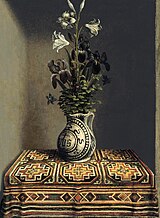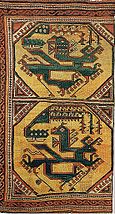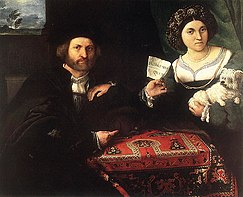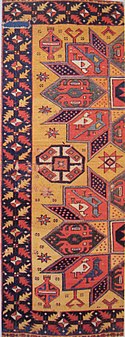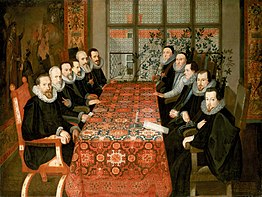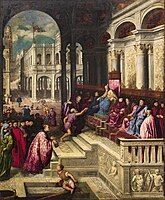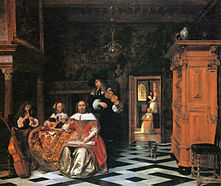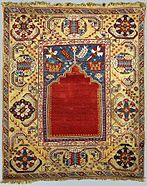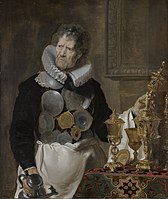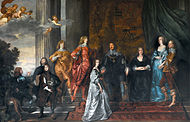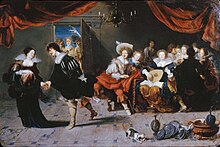
Islamic art is a part of Islamic culture and encompasses the visual arts produced since the 7th century CE by people who lived within territories inhabited or ruled by Muslim populations. Referring to characteristic traditions across a wide range of lands, periods, and genres, Islamic art is a concept used first by Western art historians in the late 19th century. Public Islamic art is traditionally non-representational, except for the widespread use of plant forms, usually in varieties of the spiralling arabesque. These are often combined with Islamic calligraphy, geometric patterns in styles that are typically found in a wide variety of media, from small objects in ceramic or metalwork to large decorative schemes in tiling on the outside and inside of large buildings, including mosques. Other forms of Islamic art include Islamic miniature painting, artefacts like Islamic glass or pottery, and textile arts, such as carpets and embroidery.

A Persian carpet or Persian rug, also known as Iranian carpet, is a heavy textile made for a wide variety of utilitarian and symbolic purposes and produced in Iran, for home use, local sale, and export. Carpet weaving is an essential part of Persian culture and Iranian art. Within the group of Oriental rugs produced by the countries of the "rug belt", the Persian carpet stands out by the variety and elaborateness of its manifold designs.

A prayer rug or prayer mat is a piece of fabric, sometimes a pile carpet, used by Muslims, some Christians, especially in Orthodox Christianity and some Baha'i during prayer.
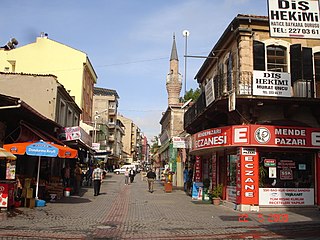
Uşak is a city in the interior part of the Aegean Region of Turkey. It is the seat of Uşak Province and Uşak District. Its population is 236,366 (2022).

Uşak carpets, Ushak carpets or Oushak Carpets are Turkish carpets that use a particular family of designs, called by convention after the city of Uşak, Turkey – one of the larger towns in Western Anatolia, which was a major center of rug production from the early days of the Ottoman Empire, into the early 20th century.

A Tabriz rug or carpet is a type in the general category of Persian carpets from the city of Tabriz, the capital city of East Azerbaijan province in northwest of Iran. It is one of the oldest rug weaving centers and makes a huge diversity of types of carpets. The range starts at Bazaar quality of 24 raj and on up to the incredibly fine 110 raj. Raj is the unit of knot density. It shows the rigidity of the rug which based on the number of strings used for the foundation of the rug. Strings materials are usually made of cotton or silk which is used for very fine rugs.
An oriental rug is a heavy textile made for a wide variety of utilitarian and symbolic purposes and produced in "Oriental countries" for home use, local sale, and export.

Bergama Carpet refers to handwoven Turkish carpets, made in the Bergama district in the Izmir Province of northwest Turkey. As a market place for the surrounding villages, the name of Bergama is used as a trade name to define the provenience.

Anatolian rug or Turkish carpet is a term of convenience, commonly used today to denote rugs and carpets woven in Anatolia and its adjacent regions. Geographically, its area of production can be compared to the territories which were historically dominated by the Ottoman Empire. It denotes a knotted, pile-woven floor or wall covering which is produced for home use, local sale, and export, and religious purpose. Together with the flat-woven kilim, Anatolian rugs represent an essential part of the regional culture, which is officially understood as the Culture of Turkey today, and derives from the ethnic, religious and cultural pluralism of one of the most ancient centres of human civilisation.

Turkish art refers to all works of visual art originating from the geographical area of what is present day Turkey since the arrival of the Turks in the Middle Ages. Turkey also was the home of much significant art produced by earlier cultures, including the Hittites, Ancient Greeks, and Byzantines. Ottoman art is therefore the dominant element of Turkish art before the 20th century, although the Seljuks and other earlier Turks also contributed. The 16th and 17th centuries are generally recognized as the finest period for art in the Ottoman Empire, much of it associated with the huge Imperial court. In particular the long reign of Suleiman the Magnificent from 1520 to 1566 brought a combination, rare in any ruling dynasty, of political and military success with strong encouragement of the arts.

Holbein carpets are a type of carpet taking their name from Hans Holbein the Younger, due to their depiction in European Renaissance paintings, although they are shown in paintings from many decades earlier than Holbein. The art historian Kurt Erdmann has sub-divided the "Holbein" design into four types ; they are among the commonest designs of Anatolian carpet seen in Western Renaissance paintings. Their production started by the mid-15th century, and continued to be produced for nearly two centuries. All are purely geometric and use a variety of arrangements of lozenges, crosses and octagonal motifs within the main field. The sub-divisions are between:

Confronted animals, or confronted-animal as an adjective, where two animals face each other in a symmetrical pose, is an ancient bilateral motif in art and artifacts studied in archaeology and art history. The "anti-confronted animals" is the opposing motif, with the animals back to back.

A Lotto carpet is a hand-knotted, patterned Turkish carpet that was produced primarily during the 16th and 17th centuries along the Aegean coast of Anatolia, Turkey, although it was also copied in various parts of Europe. It is characterized by a lacy arabesque, usually in yellow on a red ground, often with blue details. The name "Lotto carpet" refers to the inclusion of carpets with this pattern in paintings by the 16th-century Venetian painter Lorenzo Lotto, although they appear in many earlier Oriental carpets in Renaissance painting.

Islamic influences on Western art refers to the stylistic and formal influence of Islamic art, defined as the artistic production of the territories ruled by Muslims from the 7th century onward, on European Christian art. Western European Christians interacted with Muslims in Europe, Africa, and the Middle East and formed a relationship based on shared ideas and artistic methods. Islamic art includes a wide variety of media including calligraphy, illustrated manuscripts, textiles, ceramics, metalwork, and glass, and because the Islamic world encompassed people of diverse religious backgrounds, artists and craftsmen were not always Muslim, and came from a wide variety of different backgrounds. Glass production, for example, remained a Jewish speciality throughout the period. Christian art in Islamic lands, such as that produced in Coptic Egypt or by Armenian communities in Iran, continued to develop under Islamic rulers.
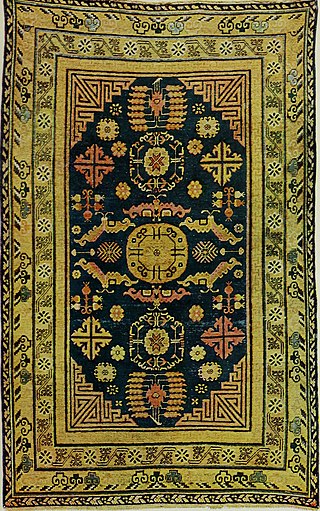
A gul is a medallion-like design element typical of traditional hand-woven carpets from Central and West Asia. In Turkmen weavings they are often repeated to form the pattern in the main field.
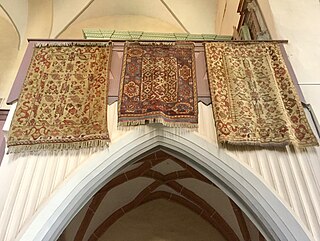
The name Transylvanian rug is used as a term of convenience to denote a cultural heritage of 15th–17th century Islamic rugs, mainly of Ottoman origin, which have been preserved in Transylvanian Protestant churches. The corpus of Transylvanian rugs constitutes one of the largest collections of Ottoman Anatolian rugs outside the Islamic world.

Anatolian animal carpets represent a special type of pile-woven carpet, woven in the geographical region of Anatolia during the Seljuq and early Ottoman period, corresponding to the 14th–16th century. Very few animal-style carpets still exist today, and most of them are in a fragmentary state. Animal carpets were frequently depicted by Western European painters of the 14th–16th century. By comparison of the few surviving carpets with their painted counterparts, these paintings helped to establish a timeline of their production, and support our knowledge about the early Turkish carpet.

The Oriental Carpet Manufacturers (OCM) was a London-based company involved in the production of, and trade with, Oriental carpets. Established in 1907/8 in Istanbul, the company set up and controlled their own carpet manufactures in the central Anatolian region around the town of Konya, and from 1911 onwards, in the Hamadan Province in northwestern Iran. In 1983 it was sold, and merged with one of its former affiliates, the Eastern Kayam Company. From 1924 until 1948, OCM was led by Arthur Cecil Edwards, who, after retiring, wrote a text book on Persian Carpets, which is still in print today.

Many studies have been conducted on Mamluk carpets, but scholars have not come to a consensus as to when or where they were made. Production of surviving Mamluk carpets started from the second half of the fifteenth century until the middle of the sixteenth century, and continued even after the Ottoman conquest of Egypt in 1517. The group of carpets produced in this period were initially called "Damascene" carpets after their attribution to Damascus, Syria. However, a Cairene origin was established after some fragments of carpets in this style were unearthed in Fustat. Furthermore, there are several eyewitness accounts by travelers placing a center of carpet production in Cairo.

The Portrait of Mehmet II is a painting by the Venetian artist Gentile Bellini, depicting the Ottoman sultan, Mehmet the Conqueror, now in the National Gallery, London. It was painted in 1480 while Bellini was in Constantinople on a diplomatic mission. This painting is a record of the significant economic and diplomatic ties that existed between Venice and the Ottoman Empire in the 15th century. Before this painting, the Ottomans had recently conquered Constantinople. This put the Venetian Republic in a situation where they had no choice but to accept a peace treaty from Mehmet the conqueror in 1479. Venice was actively tied with Constantinople through commercial links because of their close proximity to the Mediterranean sea. The importation of raw silk, cotton, illuminated manuscripts, inlaid metalwork, and spices would have ground to a halt without this peace treaty. After a peace treaty was brokered between the Venetian Republic and the Ottoman Empire, Sultan Mehmet II decided that he would like an Italian painter to be in residence at his court and paint for him; this task was placed upon Gentile Bellini. At the time, Bellini was a painter of doges, primarily in Venice. Thus, Italy's decision to send Bellini to Istanbul to paint a portrait of Mehmet II was a diplomatic gesture, aimed at fostering peace and promoting cooperation between the two nations.


